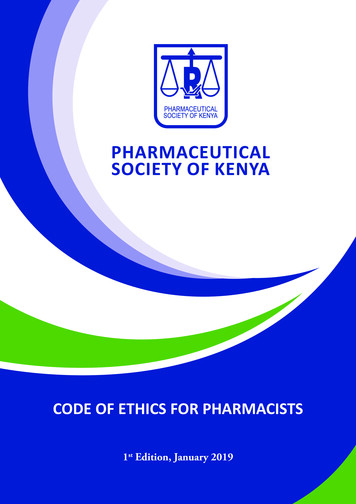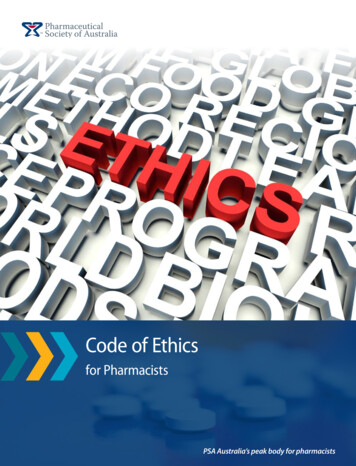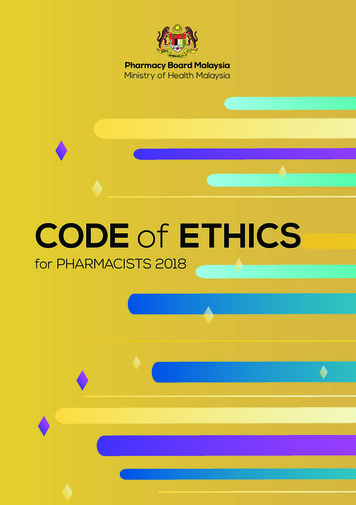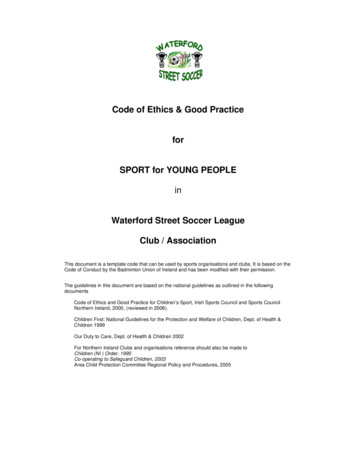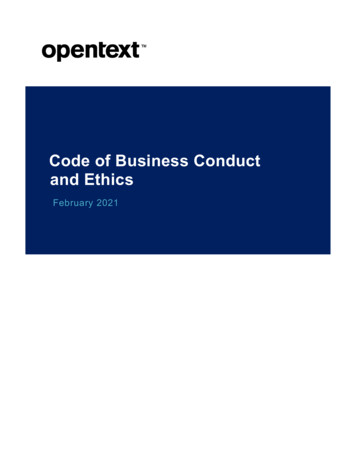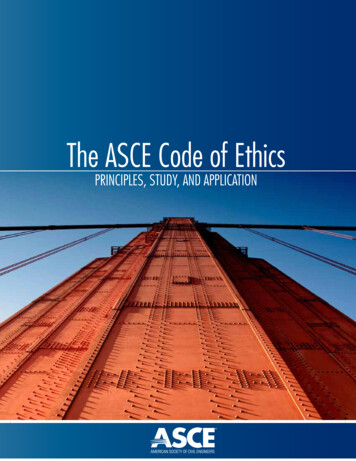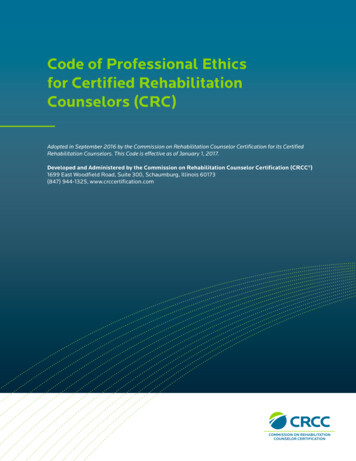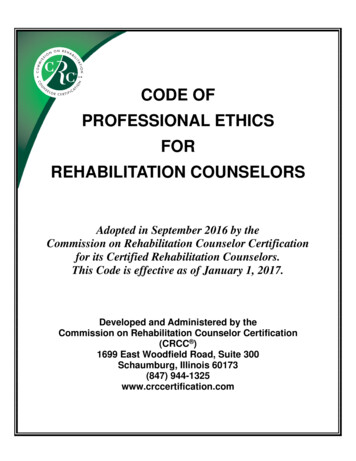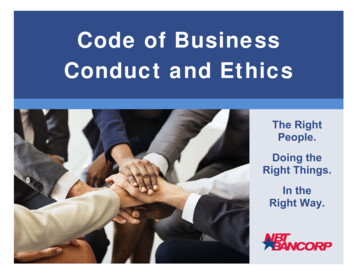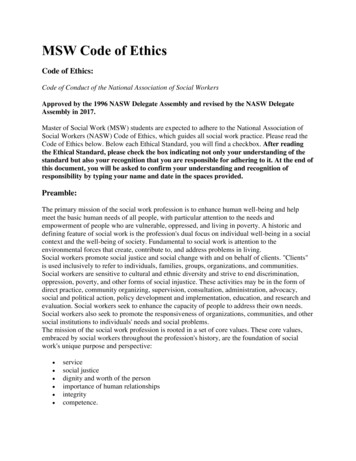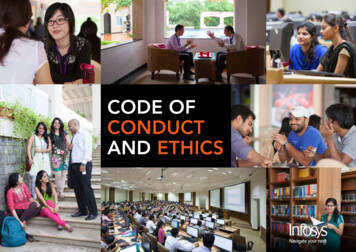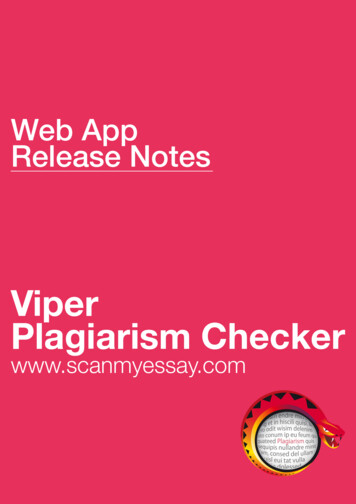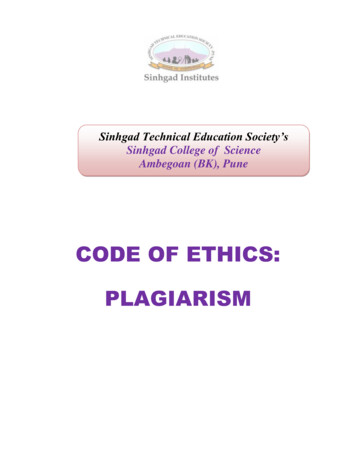
Transcription
Sinhgad Technical Education Society’sSinhgad College of ScienceAmbegoan (BK), PuneCODE OF ETHICS:PLAGIARISM
Preamble:Ethics and honesty are the two most important components of the academicactivities (be it teaching or research). Teaching & research is a novel professionbased on extremely high moral values. There cannot be any room for claiming thecredit for the work he/she has not undertaken. Many times it is observed that someof the “academicians” knowingly or unknowingly publish or present other’s workas their own. Such acts will affect healthy academic atmosphere in the institutewhich will also harm the reputation of the institute as well as the individual.It is therefore important for an academic institute to have in place a policy onplagiarism to avoid such type of acts.GUIDELINES AND CODE OF ETHICS TO CHECKMALPRACTICES AND PLAGIARISM IN RESEARCHCode of ethics is one of the ethics in research to tackle plagiarism as a researcherclaims others work as his/her own which degrades the entire research process. Ithampers the reputation of the researcher and the institution from which he/shecompletes his/her research work.Therefore, the need arises to assess the research work of the students andresearcher who produce their work in the form of research papers, research articles,project reports and research proposals. In order to make the research work crystalclear and the original on the part of researcher, it should go through the process ofplagiarism to maintain good academic standards.Matters of Ethical Concern in Research:I.Plagiarism: It is the most alarming threat towards integrity of research.Plagiarism is an act of fraud. It involves both stealing someone else'swork and lying about it afterward. It means the use of material, ideas,
figures, code or data without appropriate acknowledgement or permission(in some cases) of the original source. This may involve the following:a) Reproducing, in whole or part, text/sentences from a report, book, thesis,publication or the internet.b) Reproducing one’s own previously published data, illustrations, figures,images, or someone else’s data, etc.c) Taking material from class-notes or downloading material from internetsites, and incorporating it in one’s class reports, presentations,manuscripts or thesis without citing the original source.d) Self plagiarism which constitutes copying exactly from one's own earlierpublished work in a journal or conference proceedings withoutappropriate citations.II.Self-citation: In citing one's own unpublished work, an author must becareful not to provide the status of a manuscript. A paper should not belisted as submitted unless the Author has a written proof from thepublisher of the book or editor of a journal that the paper has beenaccepted for publication.III.Duplicate Publication: Researchers should not publish same article intwo different places. The same is applicable for abstracts. Unexplainedduplication of publication refers to self plagiarism.Mechanism to Detect Plagiarism: It is the prime responsibility of an institute or research guide todistinguish between original and plagiarized work. In order to detectthe plagiarism well known software’s/ tools (Turnitin, rammerly,Dupli checker, Copyleaks, Paperrater, Viper, Plagiarisma, PlagiarismChecker, Plagium, Plagscan, and PlagTracker etc) can be used.
Savitribai Phule University has adopted anti-plagiarism policy todetect instances of plagiarism and thereby preventing students frompublishing, presenting and copying others work. The university useTurn-It-In software to detect plagiarism.Procedure for Handling Alleged Plagiarisma. Procedural Fairness: The Institution is committed to deal with alleged plagiarismin accordance with the principles of procedural fairness, including the right to: Be informed of the allegations against them in sufficient detail to enablethem to understand the precise nature of the allegations and to properlyconsider and respond. Have a reasonable period of time within which to respond to the allegationsagainst them. Have the matter resolved in a timely manner. Impartiality in any investigation process. An absence of bias in any decision making.b. Identification and Assessment of Alleged Plagiarism: Where an examinerdetects or is made aware of alleged plagiarism by any person, the examiner mustreport the alleged plagiarism to an empowered body which confirms first if there isa plagiarism or not; if it is, then whether it is negligent or dishonest type and whatis the degree of plagiarism. This empowered body will then submit its report alongwith its recommendation to statutory bodies which are empowered to takedisciplinary actions. The severity of plagiarism can be categorized as Plagiarismwould be quantified into following levels in ascending order of severity for thepurpose of its definition:Similarities up to 10% - excluded
Level 1: Similarities above 10 to 40%Level 2: Similarities above 40 to 60 %Level 3: Similarities above 60%c. Counseling: As the detection of plagiarism and steps to prevent it are important,equally important is to educate students about the dangers of plagiarism. Institutionneeds to take steps to strengthen the moral of students so that they do not takesupport of the unfair-means.Guidelines for Action:The Institution will form a committee of about 5 experts who will examinedwhether there is plagiarism or not, if it is, then what is the level. This committeewill have a Head of the Department or the Principal as an ex-officio member. Thiscommittee will submit its report to the Academic Council for a final decision inthis regard.The committee of experts will use the best possible software provided by UGC orNational Knowledge Commission for detecting the plagiarism.
Code of Ethics: PlagiarismPlagiarism is a Cognizable Offence.The core work carried out by the student, faculty, staff and researcher shall bebased on original ideas and shall be covered by Zero Tolerance Policy onPlagiarism.The core work shall include abstract, summary, hypothesis, observations,results, conclusions and recommendations.Every submission related with research will be accompanied by anundertaking by the researcher indicating that the document is his/ her originalwork and free of any plagiarism and contain a bibliographic reference of thecopied part.Follow Good Research Practices.
Dupli checker, Copyleaks, Paperrater, Viper, Plagiarisma, Plagiarism Checker, Plagium, Plagscan, and PlagTracker etc) can be used. Savitribai Phule University has adopted anti-plagiarism policy to detect instances of plagiarism and thereby preventing students from publishing, presenting and copying others work. The university use Turn-It-In software to detect plagiarism. Procedure for Handling .
